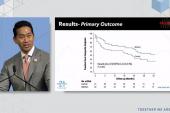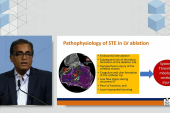Catheter Ablation May Be Underused for Supraventricular Tachycardia
“We know that catheter ablation is highly effective and can be curative for many patients who have SVT,” Jim Cheung says.

Catheter ablation was not the first-line treatment for supraventricular tachycardia (SVT) for most patients referred to a tertiary center, a study shows, with investigators suggesting the procedure is being underused in this population.
Overall, 64% of patients were not referred for ablation as the initial treatment. Factors associated with nonreferral were older age, chest discomfort during SVT, and a greater number of antiarrhythmic drugs used before ablation, researchers led by Lucas Hollanda Oliveira, MD (Federal University of São Paulo, Brazil), report online in the Journal of the American Heart Association.
These variables “indicate the existence of biases in the decision-making process in the referral process of patients who would benefit the most from catheter ablation” and “very likely suggest a skewed medical decision-making process leading to catheter ablation underuse,” they write.
Jim Cheung, MD (Weill Cornell Medicine, New York, NY), who was not involved in the study, agreed that ablation is not offered as the first option for patients with SVT as much as it should be. “Right now, we know that catheter ablation is highly effective and can be curative for many patients who have supraventricular tachycardia,” he commented to TCTMD.
But the study, he said, does not provide details about which type of physician made the initial diagnosis or about what went into individual decisions to refer patients for ablation or to try something else first. Many of these patients could have been diagnosed by internists, who perhaps would be more likely than electrophysiologists to try medications as first-line treatment rather than ablation. “And frankly, if a patient does do well and they get an episode once every several years, it may not be the wrong thing to do,” said Cheung.
Nonreferral for First-line Ablation Frequent
A prior randomized trial showed that in patients with SVT, ablation safely reduced hospitalization for persistent tachycardia cardioversion over 5 years of follow-up versus antiarrhythmic drug therapy. Moreover, drug therapy has been associated with worsening quality of life, whereas ablation has been tied to better quality of life and control of symptoms; it’s also been shown to be cost-effective in highly symptomatic patients. The authors argue that even “a small improvement in the quality of life would be enough to justify catheter ablation in SVT patients.”
International guidelines state that catheter ablation may be considered as a first-line treatment for symptomatic SVT, but prior research has demonstrated long delays between diagnosis and performance of the procedure.
There is a lot of variability between patients in terms of how frequently they have the symptoms and how well medications may be controlling them. Jim Cheung
In this study, Hollanda Oliveira et al assessed how often ablation had been considered as a first-line treatment of SVT among patients referred to a specialized electrophysiology (EP) center for the procedure. The analysis included 350 patients (mean age 41 years; 62% women) with SVT or ventricular preexcitation.
The median time between symptom onset and ablation was 60 months. Of the minority of patients who were referred for ablation as a first-line therapy, 61% underwent the procedure, but the rest did not because they didn’t have access to an EP lab (21%), refused due to a fear of complications (14%), or chose to pursue drug therapy (4%).
On multivariable analysis, the three factors independently associated with nonreferral for ablation as an initial treatment of SVT were:
- Older age (OR 1.20 per additional decade; 95% CI 1.01-1.32)
- Chest discomfort during SVT (OR 2.7; 95% CI 1.6-4.7)
- More trials of antiarrhythmic drugs before ablation (OR 1.8; 95% CI 1.4-2.3)
These factors “do not seem to be rational,” Hollanda Oliveira et al say, noting that ablation has been shown to have similar safety and efficacy in both older and younger populations. They speculate that the finding regarding chest discomfort could reflect decision-making skewed toward investigating and treating CAD, thereby neglecting SVT. And, they add, the greater likelihood of nonreferral among patients treated with more antiarrhythmic drugs initially could be an indication of physician preference for medical therapy over the procedure.
“Based on rationality, we would expect that asymptomatic ventricular preexcitation, well-controlled patients on antiarrhythmic drugs, individuals with a fewer associated number of symptoms, and those with less time since onset of symptoms would be the profile of patients not referred for catheter ablation,” as the procedure would not be beneficial in those groups,” the researchers write.
“Our findings suggest a lack of rationality in the medical decision-making process regarding SVT treatment leading to the underuse of catheter ablation,” they say, adding that “to improve quality of life and possibly reduce costs, catheter ablation should be discussed as a treatment option with patients.”
A Call for Physician Education
Providing more information about the relative risks and benefits of catheter ablation for SVT would help improve decision-making in this area, Hollanda Oliveira et al say, adding that “lack of education on the part of the referring doctor may explain, at least in part, underuse of catheter ablation as first-line therapy for supraventricular tachycardia.”
Cheung also highlighted physician education as a potential issue. These patients may be seen initially by an emergency physician, an internist, or a cardiologist, and the level of expertise regarding the treatment of SVT can vary. That will ultimately influence how many patients get referred for first-line ablation.
Improved physician education across these specialties focused on how effective ablation is and how low the risk of complications is could help address that, Cheung said.
Still, what the exact barriers are to referral for ablation requires further study, he added. “A lot of it has to do with some inherent limitations of treating patients with supraventricular tachycardia. There is a lot of variability between patients in terms of how frequently they have the symptoms and how well medications may be controlling them. A lot of these finer details may affect the ultimate decision to refer a patient or not to refer a patient.”
Todd Neale is the Associate News Editor for TCTMD and a Senior Medical Journalist. He got his start in journalism at …
Read Full BioSources
Hollanda Oliveira L, dos Santos Viana M, Moreno Luize C, et al. Underuse of catheter ablation as first-line therapy for supraventricular tachycardia. J Am Heart Assoc. 2022;11:e022648.
Disclosures
- Hollanda Oliveira reports no relevant conflicts of interest.




Comments